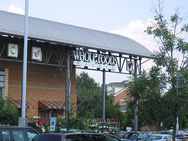Clarendon Whole Foods pays customers to drive

Photo by asmythie on Flickr.
Earlier this month, the Clarendon Whole Foods kicked off a new weekly food and wine event. If you drive and park in the Pottery Barn garage across the street, you get a $1 discount on the $5 cost. Anyone else, including those who walk, bike or take transit to the store, pays full price.
At first, I thought the discount was designed to offset customers’ cost of parking in the Pottery Barn garage. But, it turns out, Whole Foods already subsidizes that cost, validating for up to 2 hours in the garage.
With the discount, Whole Foods effectively pays people to drive to their store. As a company ostensibly committed to sustainability, they should figure out a way to reward people who don’t bring their cars at all.
I was puzzled by this peculiar incentive and asked the store about the rationale via Twitter. Whole Foods sent this explanation:
Our parking lot is well known for being crazy. Trying to encourage people who drive to use the garage.
I reached out to the management at the Whole Foods store in Clarendon via email for additional comment and explanation, but did not receive a response.
No doubt, Whole Foods is smart to encourage customers to park somewhere other than the store’s small and crowded parking lot. The store has a limited supply of a valuable resource, parking spaces, and wants them to turn over as quickly as possible.
Unfortunately, this discount policy specifically incentivizes and rewards driving and parking. This type of incentive is out of character for a company that espouses environmental sustainability as one of its values and has a “Green Mission Report” that praises employees who use public transportation and bicycles to get to work.
Besides, if keeping store-owned spaces available is the goal, Whole Foods could accomplish this far more effectively by encouraging people not to drive at all. Once a customer has driven to the store, they may still choose the convenience of the closer lot to the $1 discount and the more cumbersome garage.
If Whole Foods gives people a reason to leave the car behind altogether, these customers are guaranteed not to take up space in the coveted parking lot. What’s more, given the cost of subsidizing customers parking in a garage, Whole Foods could probably save a bundle as well.
Clarendon is a textbook example of a walkable, bikeable, and transit-accessible neighborhood. Nonetheless, parking, especially for grocery stores, has historically been a topic that has touched a nerve in the neighborhood.
Whole Foods could charge a small fee to park, thereby encouraging customers to use their parking lot sparingly. This idea is likely a non-starter, as many businesses are terrified of losing customers to stores where they don’t have to pay for parking.
Whole Foods could also extend their discount to customers who arrive by any means without a car. This is a logistical challenge, since it’s very difficult to prove that a customer walked to the store, or if they use a SmarTrip card to arrive by Metro, rather than having parked on the street or even in the store’s own lot. Producing a ticket to prove that they parked across the street, on the other hand, is easy.
Still, Whole Foods could at least level the playing field. When customers come in, Whole Foods could give them two options: a free parking validation or a $1 discount on the Wine:30 price. This approach would require Whole Foods to control access in or out of their own lot, but given the major issues they have, perhaps its time to consider this anyway.
With better controlled access, the store could still provide free parking to any driving customers, encourage people to park in the larger garage, and reward those who don’t drive, all at the same time. For instance, at checkout, a customer could choose between a lot validation, a garage validation and a 1% discount, or no parking validation and a 2% discount.
Ultimately, Whole Foods needs to find a better way to decrease congestion in their parking lot without incentivizing driving and parking. For the Clarendon neighborhood, fewer driving customers mean less traffic and a stronger, safer, walkable urban fabric.
The store, meanwhile, would better adhere to Whole Foods’ espoused corporate values and become a better community member. In a walkable, transit-rich neighborhood, it’s time for Whole Foods to stop paying its customers to drive.
